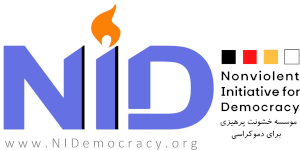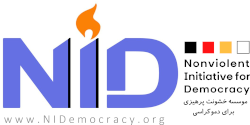By Zhina Moghadam
Pam McAllister says, “Most of what we commonly call ‘women’s history’ is actually the history of women’s role in the development of nonviolent action.”
The results obtained from a comparative study of civil resistance movements indicate that the chance of success of a campaign or civil resistance movement is directly related to the level of women’s participation in its organization and frontline. But where does this result come from?
In the Women in Resistance (WiRe) dataset, compiled and curated by Erica Chenoweth, the role of women’s participation in 338 civil resistance movements worldwide from 1945 to 2014 has been assessed. Studies show that women’s involvement in the organization and frontline of civil resistance campaigns, even under severe repression, leads to the promotion of nonviolent methods and tactics.
Erica Chenoweth and Maria Stephan, in their book Why Civil Resistance Works: The Strategic Logic of Nonviolent Conflict, studied 323 nonviolent and violent civil resistance movements from 1900 to 2013. They compared various variables and indicators influencing their success, including nonviolent discipline, participation rates, nonviolent discipline, and tactical diversity.
According to the book’s findings, nonviolent campaigns have succeeded in 57% of cases, while this percentage is only 26% for violent campaigns. This means that nonviolent campaigns are twice as likely to succeed as violent ones.
The stunning impact of nonviolence on the wide and diverse participation of people in campaigns is another important result of this book, which shows that on average, the breadth of participation in nonviolent campaigns and movements is 11 times greater than in violent campaigns.
This arises from two main reasons: first, nonviolent campaigns gain more domestic and international legitimacy, thus attracting broader and more diverse participation. Second, violent actions used to suppress nonviolent campaigns often have counterproductive results, as they create conditions for greater solidarity among neutral individuals to sympathize with the movement and lead to the fall of government supporters, subsequently making it easier to recruit them into the movement through bargaining.
In this book, a list of 95 successful nonviolent campaigns from 1949 to 2013 is presented, all of which share one common feature: high and active women’s participation at the organizational and frontline levels. Statistical analyses, considering various indices and variables, show that the active presence of women on the frontlines of campaigns increases the extent of public participation by 27 percent.
Moreover, Erica Chenoweth, Fatemeh Haghighatjoo, and Zoe Marks, in a joint note published in Foreign Affairs, highlight the role of Iranian women in the Women, Life, Freedom movement. They assert that the breadth of popular participation in movements where women are actively and significantly involved is seven times greater than movements that marginalize women.
The quantitative increase of participation in a campaign or movement means that the movement encompasses a wider spectrum of age groups, religious minorities, ethnicities, genders, and social groups, thus having a higher population diversity. Consequently, it gains quicker and easier access to sources of knowledge and skills, which are essential conditions for having more diverse and varied tactics.
Furthermore, active involvement of women in leadership and the frontlines of a movement helps maintain nonviolent discipline in critical situations. This is because the participation of diverse segments of the population in the movement means that the government will no longer be able to isolate and impose harsh and surprising conditions on a particular group to provoke violent actions in potential situations, which could then be used to justify the suppression of the movement.
On the contrary, the absence of women in leadership and frontline roles in civil resistance campaigns increases the probability of failure of those campaigns by 24 percent. It’s important to note that these privileges are by no means inherent or natural but are rooted in psychological, cultural, and historical factors that have often been structured to suppress and marginalize women.
In other words, as Ann Marie Codur and Mary Elizabeth King say in their book Women in Civil Resistance, women throughout history have invented and employed hundreds of nonviolent methods of resistance, and contemporary women activists have patiently discovered these methods. They possess five key sociological characteristics that make them more successful and effective than men in civil resistance movements:
• Women’s presence decreases the intensity of violence and repression by security forces.
• Women effectively maintain nonviolent discipline during critical moments of the movement.
• Women tend to be more inclined toward organizing within horizontal networks, which are far more efficient and flexible for organizing a movement compared to hierarchical systems by men.
• In comparison to men, women engage in less internal competition, potentially leading to more sustained solidarity than male activists.
• Women are more capable than men in expressing and creating solidarity beyond the divisive social divisions (whether religious or ethnic, economic, or social) and political competition.
Furthermore, various research indicates that women’s motivations for taking on leadership and management roles are different from those of men. Based on these findings, women’s motivation often revolves around combating discrimination in their environment, whereas the pursuit of personal benefits and individual goals can influence men’s decisions to participate in managing a collective issue. Additionally, throughout history, women have repeatedly fought for the rights of marginalized or oppressed groups, even when there was insufficient social and political space for their advocacy.
It’s important to note that nonviolence does not necessarily translate to immunity from violence. Sometimes, a nonviolent campaign, especially against oppressive governments, may still face extremely violent responses. The goal of nonviolence is not to reform the behavior of oppressors or invite them to peace, but to provide a method that the oppressed and those subject to violence can choose and take. Therefore, one should never consider the suppression of a nonviolent campaign or movement as a defeat and become discouraged. The suppression of a nonviolent campaign primarily carries the message that, despite the commitment to nonviolence, it demonstrated how effective, calculated, and dangerous it was for the government.
Historical evidence and statistical research on the political and social developments of the last hundred years indicate that the last century marked a transition from armed and violent struggles to nonviolent civil resistance. On the other hand, in the past two decades, women and sexual and gender minorities have become more powerful than ever before, both globally, and especially in developing countries. This trend began with the rise of women in the Arab Spring and the significant role played by Kurdish women in the autonomous administration of northern and eastern Syria (Rojava). It has turned into a global discourse with the #MeToo movement, and has reached its peak with the Woman, Life, Freedom movement in Iran. All of these narratives illustrate that even the most fundamentalist governments and patriarchal cultures are not immune to the political and social agency of women. Therefore, it is expected that the century ahead will be an era of consolidating a culture of nonviolence and dismantling violence-based and oppressive systems.
To explain this further, we will not need to refer to examples of foreign countries, because the daily efforts and struggles of Iranian women over the past 40 years can be considered the most prominent manifestation of this trend. Iranian women, while deprived of not only their political and social participation rights but also the right to their own bodies during all these years, have created golden opportunities for self-empowerment from the smallest existing or possible openings within the narrow legal frameworks of the ruling system and the siege of harsh patriarchal values.
For example, currently, 60% of Iran’s student population is female, and more than 35% of young Iranian women (aged 25 to 34) have university educations, which is higher than the percentage of young women in Germany and Italy and, interestingly, 10% higher than Iranian men.
In addition, following the sudden drop in oil prices in the late 1960s and the subsequent change in Iran’s population policies of the Islamic Republic, Iranian women saw an opportune moment to initiate an unprecedented transformation in the fertility rate. In the late 1960s, Iran’s fertility rate was close to seven children per woman. By the late 1990s, this number had dropped to 1.6 children per woman. Sociologists and demographers consider this to be the fastest fertility rate decline in world history, and feminist theorists refer to it as “a sign of a unique feminist revolution in silence and under the veil.”
In the following, we’ll discuss in more detail some of the prominent events and trends that Iranian women, sometimes openly and sometimes secretly, have made at different times by adopting nonviolent methods, tactics, and campaigns.



